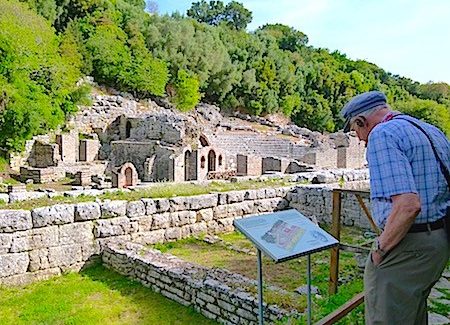Shore Excursion: Visiting Butrint, a microcosm of Mediterranean history
By Jackie Sheckler Finch
Exiles from the fall of Troy were happy to find a new place to call home. Giving thanks for their refuge, the exiles were sacrificing an ox on their ship before coming ashore.
“But the bull jumped overboard and swam ashore,” said guide Demyr. “Taking this as a good omen, the place was named Buthrotum which means ‘wounded ox,’ the ancient name for Butrint.”
Today, Butrint in Albania is a microcosm of Mediterranean history. It represents the rise and fall of the great empires that dominated this region. Inhabited since prehistoric time, Butrint was at various times the site of a Greek colony, a Roman city, a base of Christianity in the Byzantine Empire and a Venetian stronghold. The city was abandoned in the late Middle Ages after marshes formed in the area.
Now a UNVESCO World Heritage Site, the ruins are in amazingly good condition with more being discovered as times goes by.
One of the important aspects of the area that became Butrint was the presence of water. “Romans loved water,” Demyr said, pointing out the ruins of early bathhouses. “Good drinking water was abundant here.”
Butrint owes its early fame to a sanctuary dedicated to the god of medicine, Asclepius. Located on the south slope of the hill, the sanctuary was founded in the 4th century BC and would draw worshippers hoping to be healed.
“Butrint’s water was said to have sacred powers,” Demyr said. Worshippers who were healed or hoped to be would leave money or symbolic gifts to the god Asclepius and his priests.
Virgil’s epic poem, The Aeneid, tells of Aeneas visiting Butrint on his way to Italy. A well-preserved Greek theatre was built against the slope of a hill and still has excellent acoustics
Early Christianity found at Butrint
In the early 6th century, Butrint became the seat of a bishop and the remains of a large baptistery can still be seen today. “The resurrection message was to embrace a new life and be baptized, be regenerated,” Demyr said.
The marvelous mosaic floor of the baptistery is still preserved and a small portion has been left exposed so visitors can see it. The overall design consists of seven bands encircling the baptismal font at the center which makes it eight bands – the Christian number of salvation and eternity.
The main entrance displays two large peacocks in a vine growing from a huge vase. The peacocks symbolize paradise and immortality. The vase and the grapes represent the Eucharist and the blood of Christ.
Later, Butrint became a small fishing village clustered around a castle. The settlement was governed by Ali Pasha, whose fame as a ruthless ruler earned him the nickname “The Muslim Bonaparte.” Ali Pasha built the castle at the mouth of the river channel.
Among the visitors to Ali’s court was Lord Byron who recorded the encounter in his poem Childe Harold. Although he noted the splendor of Ali Pasha’s castle, Byron wrote in a letter to his mother that Ali Pasha “is a remorseless tyrant, guilty of the most horrible cruelties…” Although he was promised safety, Ali Pasha was killed and beheaded in 1822.
In 1928, an Italian archaeological mission came to Butrint and began the excavations that visitors see today. About 40 percent of the ancient city has been uncovered.
“We are walking on the tops of roofs and walls,” Demyr said. “We are finding things all the time. More is just waiting to be discovered.”
Photo by Jackie Sheckler Finch















View Recent Comments